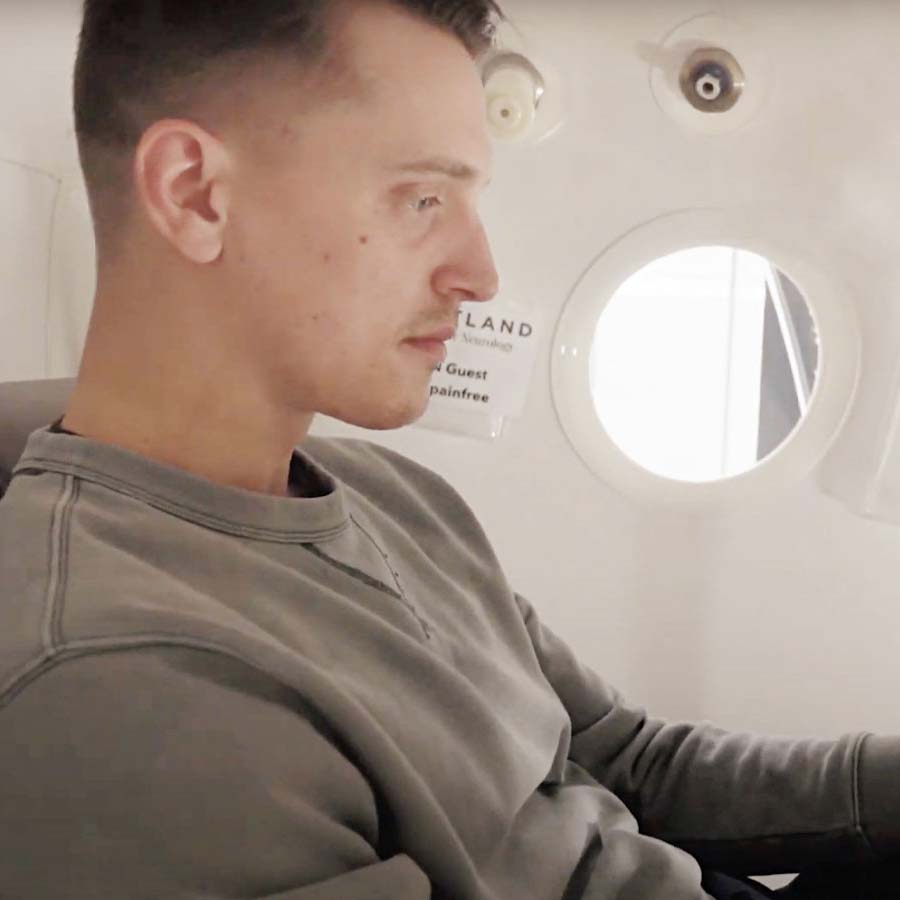
Treating Neurodevelopmental Disorders with Hyperbaric Oxygen Therapy
Hyperbaric Oxygen Therapy (HBOT) has been shown both in research and clinically to improve the health of children with Neurodevelopmental disorders. HBOT supercharges healing and improves function in the brain by increasing oxygen levels within the plasma of our blood while also stimulating growth hormones in our brain that create new neurological connections in a process known as neuroplasticity. In addition, HBOT also reduces swelling and neuro-inflammation, releases stem cells, grows new blood vessels, improves detoxification and overall circulation that is essential for healthy brain function.
Neurodevelopmental disorders have a wide range from mild impairments to those severely impacting a person’s life. They impact the brain during neurological development, which is why hyperbaric oxygen therapy may improve function in these individuals. The brain requires a tremendous amount of oxygen to function appropriately. Healing requires even more oxygen as it creates the energy needed for regeneration of cellular processes.
Through the use of functional MRI, SPECT and PET scans, we’ve been able to hyperbaric oxygen therapy improving the brains of these patients as have also been reported by families and by the patients themselves.
Common conditions?
Neurodevelopmental Disorders are an umbrella term that may include:
- Autism Spectrum Disorder
- Aspbergers
- Attention-Deficit/Hyperactivity Disorder
- Learning Disabilities
- Cerebral Palsy
- Speech and Language Disorders
- Tourette Syndrome
- Fragile X Syndrome
- Schizophrenia
- Hearing and Visual Impairment
How can hyperbaric oxygen therapy help with Neurodevelopmental Disorders?
- providing abundant levels of plasma-rich oxygen to our brain tissue for healing
- reducing neuro-inflammation throughout our brain and body
- stimulating release of growth factors such as trophic factor to enhance neuroplasticity for the repair and regeneration of brain cells and their connections (synapses)
- stimulating growth of new blood vessels to supply the brain with greater circulation and oxygen to promote brain repair and regeneration by releasing greater amounts of vascular endothelial growth factor
- balancing our fight or flight and relaxation and digestion systems by strengthening the health of our autonomic nervous system, impacting blood flow within our brain that leads to dizziness, headaches, slow processing, memory changes and many other symptoms
- increasing stem cell production for healing
- improving detoxification
- enhancing cerebrospinal fluid flow
Autism is a neuro-developmental disorder associated with hypoperfusion to several areas of the brain, defects of neurogenesis, and impairments of neuronal migration (Wegiel et al.). Thereby, increasing blood flow and oxygen to these regions could provide a potential therapeutic benefit to ASD patients. In fact, Rossignol and others found that 40-hours of HBOT, 24% oxygen at 1.3 ATM produced significant improvement in children’s overall functioning, receptive language, social interaction, eye contact, and sensory/cognitive awareness compared to those receiving slightly pressurized room air.
Increasing blood flow to the brain increases oxygen and other nutrients that can improve brain function and stimulate Neuroplasticity, which is how we rewire our brains to function desirably and can improve focus, concentration and behavior in ADHD spectrum children. Incorporating functional neurology rehabilitation as seen in Chiropractic Neurology, Neuropsychology, Occupational Therapy, Speech Pathology would be additionally beneficial in combination with hyperbaric oxygen therapy to maximize brain changes.
Clinically, we have experienced positive success with ASD patients at our clinic. It’s extremely safe and is often tolerated well by these patients, especially when joined by parents during hyperbaric oxygen therapy when necessary.
Other benefits of hyperbaric oxygen therapy
Hyperbaric Oxygen Therapy is a quickly evolving science and the full benefits are continually being discovered. HBOT increases the amount of oxygen in our bloodstream and increases circulation to deliver abundant amounts of oxygen to the brain, supersaturating our tissue with energy needed for healing, growth, and repair. This creates a healthier environment for our brain to work and control our autonomic nervous system. Because of this, the benefits of hyperbaric oxygen therapy can be found in all parts of the body and in a wide range of ways. Some benefits can include:
- Faster healing from trauma
- Reduced inflammation
- Increased stem cell release
- Improved brain health
- Detoxification
- Improved autonomic nervous system function
- …and many more
Learn more about the many benefits of HBOT and how it works.
Supporting Research
- Studies show that Autism Spectrum Disorder, ADHD, learning disabilities and other Neuro developmental disorders may be improved with the use of Hyperbaric Oxygen Therapy. Although more research is needed, it certainly is a safe and well tolerated manner of treatment that improves blood flow to the brain and decreases neuroinflammation without worsening oxidative markers.
- The first multicenter, randomized, double-blind, controlled trial in 2009 found that 40-hour HBOT of 24% oxygen at 1.3 ATM produced significant improvement in children’s overall functioning, receptive language, social interaction, eye contact, and sensory/cognitive awareness compared to those received slightly pressurized room air (Rossignol et al).
- “A number of individuals with ASD possess certain physiological abnormalities that HBOT might ameliorate, including cerebral hypoperfusion, inflammation, mitochondrial dysfunction and oxidative stress.” (Rossignol et al).
- Most studies with HBOT in children with ASD reported improvements in several behavior domains, although many studies were not controlled as described by Rossignol et al.
- Utilizing low pressure chambers is well tolerated by children and has also been shown by Rossignol and his team to provide the greatest neurocognitive improvement, as opposed to deeper pressure chambers.
- HBOT remains among the safest therapies used today. The side effects that have been described are self-limiting and often can be avoided with adequate screening.
Sources
- Rossignol DA, Bradstreet JJ, Van Dyke K, Schneider C, Freedenfeld SH, O’Hara N, Cave S, Buckley JA, Mumper EA, Frye RE. Hyperbaric oxygen treatment in autism spectrum disorders. Med Gas Res. 2012 Jun 15;2(1):16. doi:
- Rossignol, D.A., Rossignol, L.W., Smith, S. et al. Hyperbaric treatment for children with autism: a multicenter, randomized, double-blind, controlled trial. BMC Pediatr 9, 21 (2009). https://doi.org/10.1186/1471-2431-9-2110.1186/2045-9912-2-16. PMID: 22703610; PMCID: PMC3472266.
- Mukherjee A, Raison M, Sahni T, Arya A, Lambert J, Marois P, et al. Intensive rehabilitation combined with hyper- baric treatment in children with cerebral palsy: A controlled longitudinal study undersea Hyperb Med. 2014.
- Lacey DJ, Stolfi A, Pilati LE. Effects of hyperbaric oxy- gen on motor function in children with cerebral palsy. Ann Neurol. 2012; 72(5): 695-703.
- Hardy P, Collet JP, Goldberg J, Ducruet T, Vanasse M, Lambert J, et al. Neuropsychological effects of hyperbaric oxygen therapy in cerebral palsy. Dev Med Child Neurol. 2002; 44(7): 436-46.
- Collet JP, Vanasse M, Marois P, Amar M, Goldberg J, Lambert J, et al. Hyperbaric oxygen for children with cerebral palsy: a randomised multicentre trial. HBO-CP Research Group. Lancet. 2001; 357(9256): 582-6.
- Montgomery D, Goldberg J, Amar M, Lacroix V, Lecomte J, Lambert J, et al. Effects of hyperbaric oxygen therapy on children with spastic diplegic cerebral palsy: a pilot project. undersea Hyperb Med. 1999; 26(4): 235-42.
- James PB. Hyperbaric oxygenation for cerebral palsy. Lancet. 2001; 357(9273): 2052-3.
- Chen Z, Ni P, Lin Y, Xiao H, Chen J, Qian G, et al. Visual pathway lesion and its development during hyperbaric oxygen treatment: a bold- fMRI and DTI study. J Magn Reson Imaging. 2010; 31(5): 1054-60.
- Huang L, Obenaus A. Hyperbaric oxygen therapy for traumatic brain injury. Med Gas Res. 2011; 1(1): 21.
- Neubauer RA, James P. Cerebral oxygenation and the recoverable brain. Neurol Res. 1998; 20 Suppl 1: S33-6.
- Heyboer M 3rd, Sharma D, Santiago W, McCulloch N. Hyperbaric Oxygen Therapy: Side Effects Defined and Quantified. Adv Wound Care (New Rochelle). 2017 Jun 1;6(6):210-224. doi: 10.1089/wound.2016.0718. PMID: 28616361; PMCID: PMC5467109.
- Wegiel J. et al. The neuropathology of autism: defects of neurogenesis and neuronal migration, and dysplastic changes. Acta Neuropathol. 2010;119(6):755–70. doi: 10.1007/s00401-010-0655-4.
Contact Us
Ready to discuss how hyperbaric oxygen therapy can help you heal, rebuild and restore health?
Contact Us